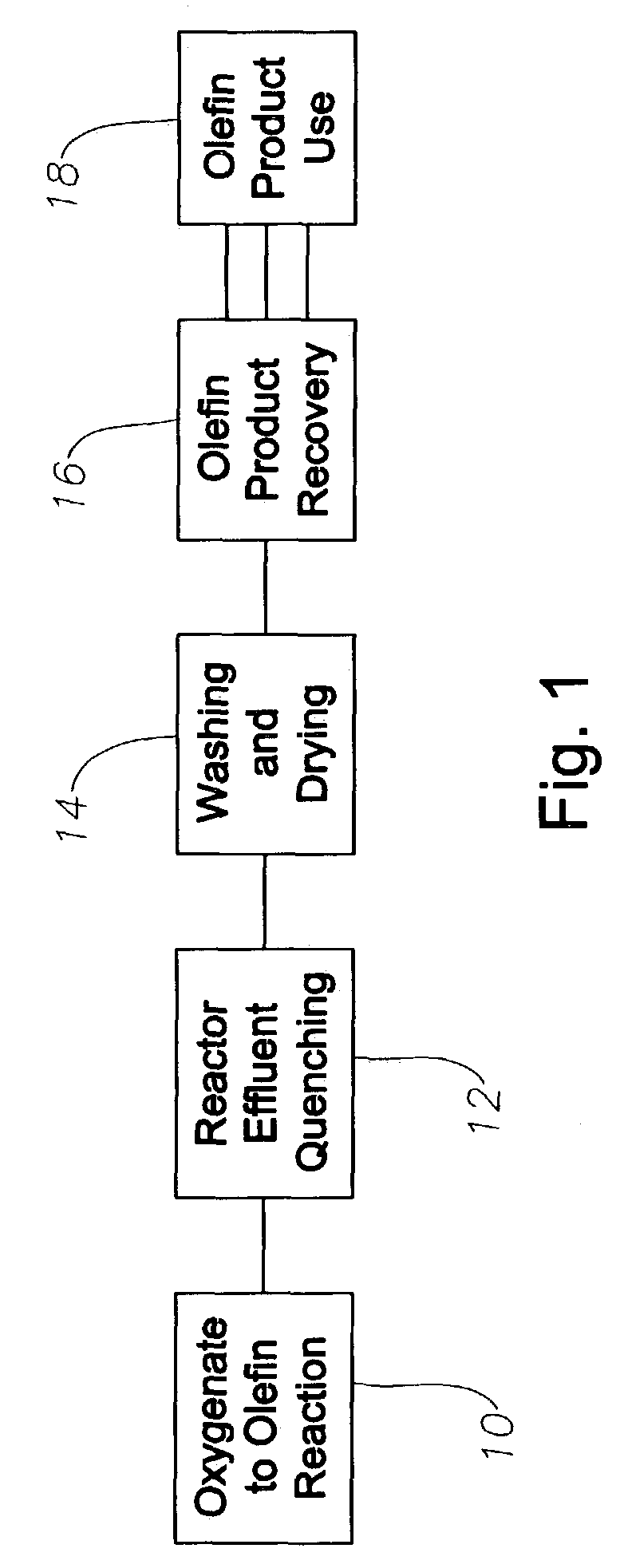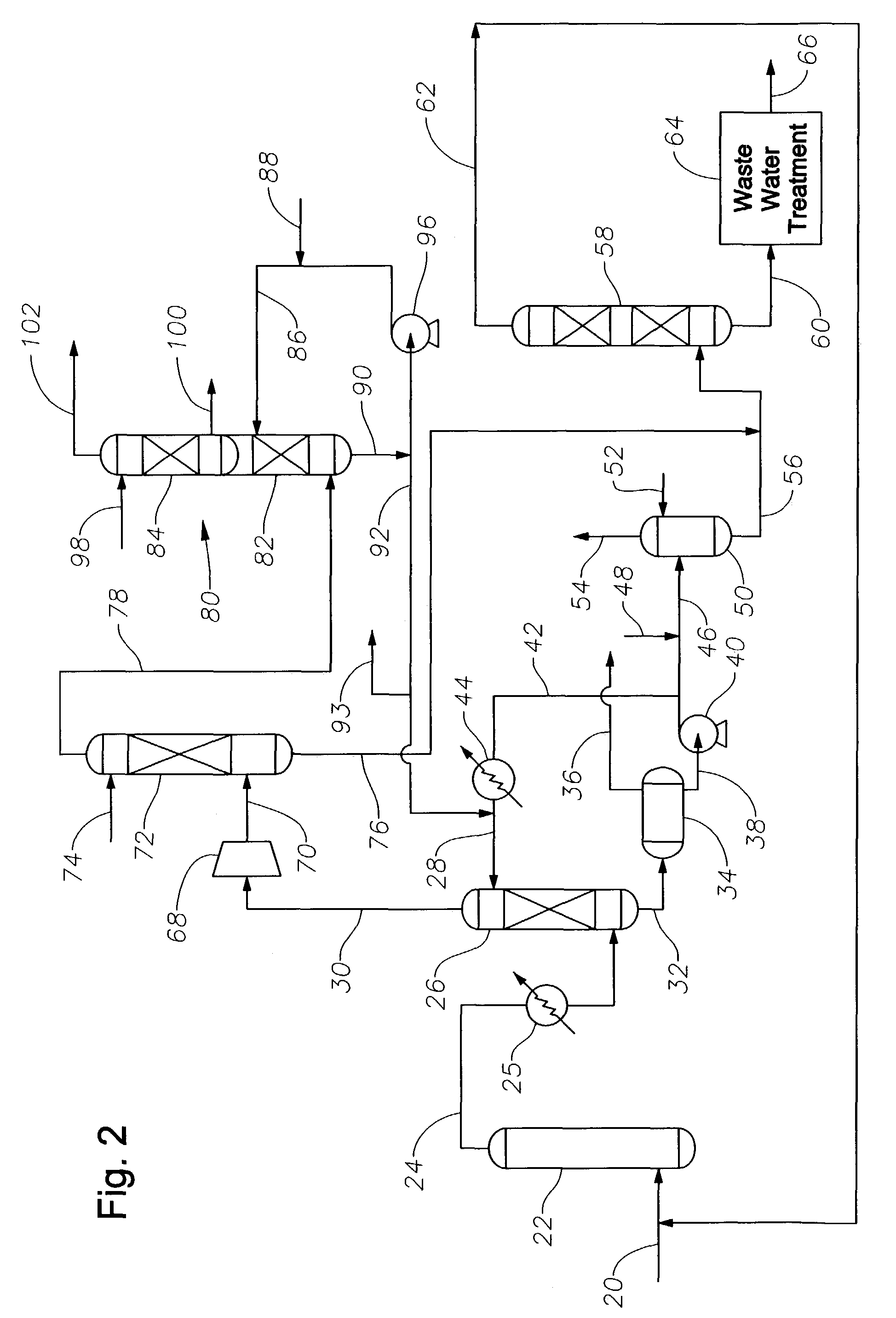Process for separating carbon dioxide from an oxygenate-to-olefin effluent stream
a technology of oxygenate and effluent, which is applied in the direction of extraction purification/separation, separation process, hydrocarbon oil treatment product, etc., can solve the problem of unreacted methanol likely to be present in the effluent, and achieve the effect of reducing the alkalinity and reducing the amount of carbon dioxid
- Summary
- Abstract
- Description
- Claims
- Application Information
AI Technical Summary
Benefits of technology
Problems solved by technology
Method used
Image
Examples
example 1
[0137]The flow diagram illustrated in FIG. 2 is used in Example 1. Effluent from the oxygenate to olefin reactor 22 passes through quench device 26 which removes water in the effluent stream (including the reactor effluent stream and the cooled effluent stream) and produces a quenched effluent stream. The quench medium is supplied along line 28. The pH of the quench medium is adjusted by adding alkaline from line 92 to line 28. According to this example, the alkaline is sodium hydroxide (NaOH). A portion of the carbon dioxide is removed in the quench device 26. The quenched effluent stream leaves the quench device 26 and directly or indirectly passes through an alkaline wash tower 80. The remainder of the carbon dioxide is removed from the quenched effluent stream in the alkaline wash tower 80. A portion of the bottoms stream 90 of the alkaline wash tower 80 is transported along line 92 to adjust the pH of the quench medium.
[0138]According to this example, a reactor effluent stream ...
example 2
[0143]The process of example 1 was followed in example 2 except that the pH of the quench medium was adjusted to 7. All acetic acid is removed and no carbon dioxide is removed in the quench device 26. All of the carbon dioxide is removed in the alkaline wash tower 80. The conditions for operating the quench device 26 and the alkaline wash tower 80 are shown in Table 2.
[0144]
TABLE 2Conditions of Quench DeviceAnd Alkaline Wash Tower in Example 2Alkaline WashQuench Device / QuenchTower / AlkalineConditionMediumWash MediumPressure2.72 atm18 atmTemperature of100° F.110° F.MediumpH of Medium7.014NaOH used per hour113 lbs / hr1828 lbs / hrNaOH used per0.42 kTa6.77 kTaprocessing 1000 kTa ofethylene and 1000 kTaof propylene
[0145]Under the foregoing conditions, a total of 1941 lbs / hr are used in the quench device 26 and alkaline wash tower 80. The process described in Example 2 uses 7.19 kTa of NaOH to process 1000 kTa of ethylene and 1000 kTa of propylene. A comparison of example 1 and example 2 ill...
PUM
| Property | Measurement | Unit |
|---|---|---|
| Fraction | aaaaa | aaaaa |
| Weight | aaaaa | aaaaa |
| Concentration | aaaaa | aaaaa |
Abstract
Description
Claims
Application Information
 Login to View More
Login to View More - R&D
- Intellectual Property
- Life Sciences
- Materials
- Tech Scout
- Unparalleled Data Quality
- Higher Quality Content
- 60% Fewer Hallucinations
Browse by: Latest US Patents, China's latest patents, Technical Efficacy Thesaurus, Application Domain, Technology Topic, Popular Technical Reports.
© 2025 PatSnap. All rights reserved.Legal|Privacy policy|Modern Slavery Act Transparency Statement|Sitemap|About US| Contact US: help@patsnap.com



